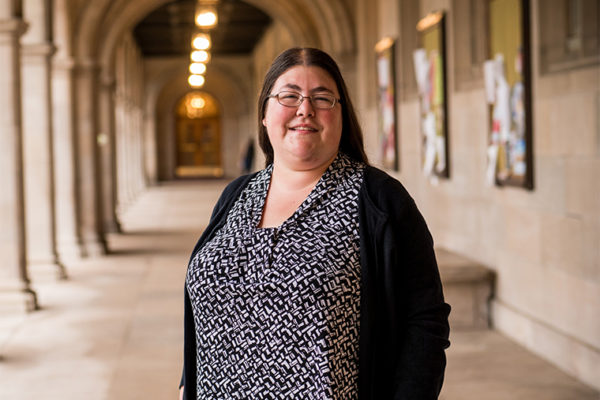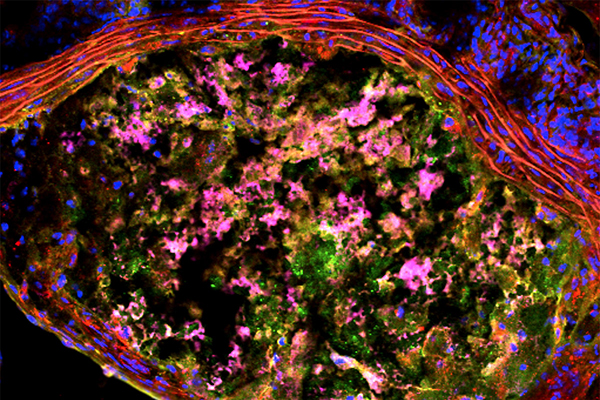Engineering proteins to help counter devastating diseases
Meredith Jackrel, assistant professor of chemistry in Arts & Sciences, recently received a five-year grant from the National Institutes of Health (NIH) and another from the Longer Life Foundation to study protein disaggregases — evolved protein forms that mitigate protein misfolding — as a strategy to combat neurodegenerative diseases such as Alzheimer’s, Parkinson’s and ALS.
Medical history can point to earlier Parkinson’s disease diagnosis
Researchers at the School of Medicine have analyzed Medicare claims data of more than 200,000 people to develop an algorithm to predict whether a patient one day will be diagnosed with Parkinson’s.
Atherosclerosis is Alzheimer’s disease of blood vessels, study suggests
Studying mice and tissue samples from the arteries of patients with atherosclerosis, researchers at Washington University School of Medicine in St. Louis suggest this plaque accumulation is driven, at least in part, by processes similar to the plaque formation implicated in brain diseases such Alzheimer’s and Parkinson’s.
Washington People: Gammon Earhart
Gammon Earhart, PhD, a professor in the Program in Physical Therapy at the School of Medicine, works to restore movement to patients with Parkinson’s disease. Arguably her most significant contributions as a researcher have been her studies demonstrating the
benefits of tango dancing on patients with Parkinson’s. Freedom of movement, it turns out, has become a theme of sorts for Earhart — professionally and personally.
Receptor may aid spread of Alzheimer’s and Parkinson’s in brain
School of Medicine
scientists have found a way that corrupted, disease-causing proteins
spread in the brain, potentially contributing to Alzheimer’s disease,
Parkinson’s disease and other brain-damaging disorders. Pictured are clumps of corrupted tau protein outside a nerve cell, as seen through an electron micrograph.
Washington People: Kevin Black
Kevin Black’s family didn’t have any physicians in it. Well, one of his great-great-grandfathers had a medical license back in the late 1800s, but he had no formal training — and Black himself wasn’t planning on medical school. But during his first year of college, a teacher helped change his career plans.
Brain scans show effects of Parkinson’s drug
Neuroscientists using a new brain imaging technique could see an investigational drug for Parkinson’s disease get into a patient’s brain and affect blood flow in several key structures, an indicator the drug may be effective. In the future, similar brain scans could speed the development of new drugs and help clinicians learn whether established drugs are working.
Tweet: Scientists decode songbird’s genome
Nearly all animals make sounds instinctively, but baby songbirds learn to sing in virtually the same way human infants learn to speak: by imitating a parent. Now, an international team of scientists, led by the School of Medicine, has decoded the genome of a songbird — the Australian zebra finch — to reveal intriguing clues about the genetic basis and evolution of vocal learning.
Brain region learns to anticipate risk, provides early warnings, suggests new study in Science
Joshua Brown of WUSTLA new theory suggests that the brain may subconsciously help us avoid risky situations.While some scientists discount the existence of a sixth sense for danger, new research from Washington University in St. Louis has identified a brain region that clearly acts as an early warning system — one that monitors environmental cues, weighs possible consequences and helps us adjust our behavior to avoid dangerous situations. “Our brains are better at picking up subtle warning signs than we previously thought,” says WUSTL research psychologist Joshua Brown, co-author of a study on these findings in the Feb. 18 issue of the journal Science.
Brain region learns to anticipate risk, provides early warnings, suggests new study in Science
Joshua Brown of WUSTLA new theory suggests that the brain may subconsciously help us avoid risky situations.While some scientists discount the existence of a sixth sense for danger, new research from Washington University in St. Louis has identified a brain region that clearly acts as an early warning system — one that monitors environmental cues, weighs possible consequences and helps us adjust our behavior to avoid dangerous situations. “Our brains are better at picking up subtle warning signs than we previously thought,” says WUSTL research psychologist Joshua Brown, co-author of a study on these findings in the Feb. 18 issue of the journal Science.
View More Stories



